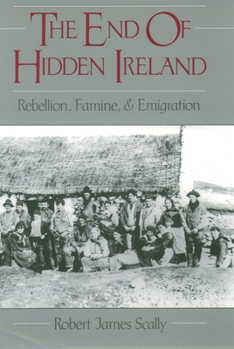The End of Hidden Ireland: Rebellion, Famine, and Emigration
Select Format
Select Condition 
Book Overview
Many thousands of Irish peasants fled from the country in the terrible famine winter of 1847-48, following the road to the ports and the Liverpool ferries to make the dangerous passage across the Atlantic. The human toll of "Black '47," the worst year of the famine, is notorious, but the lives of the emigrants themselves have remained largely hidden, untold because of their previous obscurity and deep poverty. In The End of Hidden Ireland, Scally...
Format:Paperback
Language:English
ISBN:0195106598
ISBN13:9780195106596
Release Date:June 1996
Publisher:Oxford University Press
Length:288 Pages
Weight:1.00 lbs.
Dimensions:0.8" x 6.1" x 9.3"
Customer Reviews
4 ratings
A scholarly picture with limitations
Published by Thriftbooks.com User , 16 years ago
Robert Scally's book is the product of detailed research into the wiping out of the Irish village or "townland" of Ballykilcline in County Roscommon around the time of the great famine of the mid 19th century in Ireland and the forced emigration of its people to the Liverpool area of Lancashire and to the United States and Canada. The book starts with a description of the British imposed land ownership system in Ireland at the time, the landlords' financial difficulties which led to their desire to clear the land of their troublesome tenants by assisting them on their way, made easier by the famine. But the book presents an incomplete picture because of Scally's failure to consider context and history. Even the title is misleading. "Hidden Ireland", presumably meaning the remnant of the Gaelic culture which still stubbornly remained in the culture and language of the townland people and particularly in their attitude about use and ownership of land, had been receding in defeat for many years. Starting in 1607 with the defeat of the great northern leaders, O'Neill and O'Donnell and the "Flight of the Earls", the slow removal of native Irish leaders and the seizure of land by the colonizers, the Penal Laws of 1695 effectively proscribing the Catholic religion, and the Act of Union in 1800 after the United Irishman rebellion of 1798 were all aimed at destroying the Gaelic, Catholic, Irish nation. In fact they were never completely successful, and certainly the effort did not end with the leveling of Ballykilcline although it was a part of a low point for the Irish nation. The Irish people were never fully subjugated; nor were the peasants the docile, cultureless ignoramuses painted by Scally, poor though they may have been. It was these very peasant people who supported Daniel O'Connell, the Catholic "Liberator" in his mass rallies in 1823, the more radical Fenians in 1860, Michael Davitt's National Land League in 1879 and the Sinn Fein movement founded in 1905 which finally won victory in elections for the Irish Dail and ultimately Ireland's freedom from Britain. "Hidden Ireland" has in many ways never disappeared and has emerged in our times, wounded but victorious, perhaps in a slightly different form. History is an unfolding tapestry, not a snapshot of a limited period. It is this which gives Scally's dismal portrait its dark and false color. If one does not understand the traditional Irish view of land ownership and cooperative use and its conflict with the English "metes and bounds" system which the conquerors saw as normal one cannot understand the views of the townland people. The old Gaelic and Brehon legal system of course did give way in our times. Another example of Scally's puzzlement is that he doesn't seem to realize that the Irish people saw the National School system brought by the English, in spite of its advanced, modern benefits, as part of the English plan to destroy their national culture and language and for that reason
Shocking reading about my own ancestors.
Published by Thriftbooks.com User , 23 years ago
The trauma and distress my own ancestors went through during this famine period was horrible. In the ten year period Ballykilcline lost over 90% of its population from disease, eviction, emigration and death by starvation. My own ancestors lived in Kilglass Parish where they lost 55% of their population. Robert James Scally's book gave me a very clear understanding of what transpired from about 1835 to 1850.
Thorough explanation of the cause of Ireland's devistation
Published by Thriftbooks.com User , 26 years ago
Scally does an excellent job of using historical facts to present a better picture of a devistated Ireland. Americans in particular often misunderstand the cause of the chaos usually blamed on the potato blight. In reality, the famine was only the "icing on the cake", which Scally explains well. The first half of the book is a very detailed description of Ireland in the days immediately preceeding the famine. The second half walks us through the once-green hills of a broken Ireland, passing sunken faces and hungry eyes. Scally has been accused of leaving historical fact for emotional imagination. I submit the idea that every historian must create something from imagination at some point. Although we can read facts, we must paint the scenes in our minds. This is an excellent book to read if you are already interested in "Black '47" and is also good for the serious reader who cares to explore the Emerald Isle of 150 years ago . . . this is also an important source for an Irish-American who would like to better understand his or her roots, like me. Perhaps those of us who have ties to the isle are more likely to appreciate the suffering that happened there.
Very VERY comprehensive
Published by Thriftbooks.com User , 26 years ago
I give this book a "7" mostly because Scally should get a lot of credit for all the research he did for this book. It's very obvious. However, I would not recommend it if you are looking for a quick and easy read. This book is best for someone studying the famine and migration of the Irish to America.






